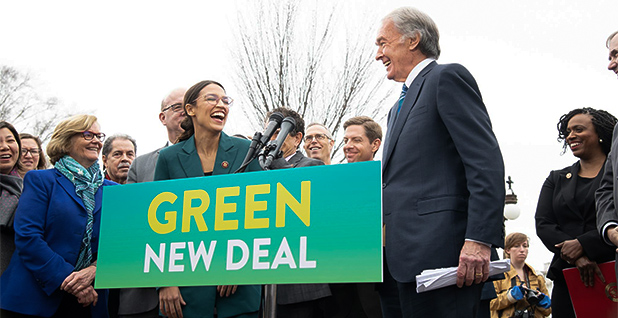Precedent for the Next Green New Deal
by Jon Biemer
There is talk of a Green New Deal. Pundits complain that it is merely a wish list of social, environmental and economic proposals. That it lacks substance. That it is going to be expensive. But there is ample precedence we can make it happen.
The Original New Deal
Douglas Brinkley, in Rightful Heritage: Franklin D. Roosevelt and the Land of America, spells out the environmental facets of the first New Deal. It was remarkably green. During the 1930s, 711 state parks were dedicated to the common good, while 20 million people were put to work. The Civilian Conservation Corps was well named.
Add to that the establishment of 140 National Wildlife Refuges. Add to that the establishment of 29 national parks and monuments – including Everglades National Park in Florida, Great Smokies National Park in the Appalachian Mountains, and Big Bend National Park in Texas.
Earth Day’s Legacy
The canon of environmental legislation which followed the first Earth Day, April 22nd 1970, certainly qualifies as a second Green New Deal, even if it was not labeled as such. During the 1970s, Congress passed, and three presidents signed into law, game-changing legislation which included:
- the Clean Air Act of 1970
- the Water Quality Improvement Act of 1970
- the Water Pollution and Control Act Amendments of 1974
- the Resource Conservation and Recovery Act of 1976 – controlling hazardous waste
- the Toxic Substances Control Act of 1976 – requiring testing and record keeping
- the Occupational Safety and Health Act of 1970
- the Federal Environmental Pesticide Control Act of 1972
- the Endangered Species Act of 1973
- the Safe Drinking Water Act of 1974
- the Federal Land Policy and Management Act of 1976 – regarding lands overseen by the Bureau of Land Management
- the Surface Mining and Reclamation Act of 1975
- the Comprehensive Environmental Response, Compensation, and Liability Act of 1980 – better known as the Superfund Act to clean up toxic waste sites.
Two lesser known pieces of legislation during this period gave me a career working for the environment. The Solar Heating and Cooling Demonstration Act of 1974 provided funds for large solar systems on schools and hospitals. That gave me a job as a project engineer with a consulting firm specializing in solar energy. The Northwest Power and Conservation Act of 1980 put Bonneville Power Administration into the conservation and renewable energy business, allowing me to move to Portland and help implement regional conservation programs.
Thousands of professionals have built careers on the shift in consciousness initiated by that first Earth Day. Legislation and rulemaking from that period still serve the common good.
Obama’s Environmental Legacy
The term Green New Deal was actually coined in reference to the environmental agenda embedded in the American Recovery and Investment Act of 2009.[1] Included in this recession-induced economic stimulus package were: $25 billion to promote renewable energy through investment grants, production tax credits, and loan guarantees; $20 billion to support energy conservation; $10 billion to support investments in electrical grid upgrades; and $5 billion to support advanced vehicle technologies such as batteries for electric cars.
As a result, we have seen rapid growth in wind and solar power, a growing fleet of electric cars, and a reduction in U.S. carbon-dioxide emissions by 28 percent between 2009 and 2017. By the way, the economy rebounded well before the end of Barack Obama’s administration.
The Next Green New Deal
The goals of the next Green New Deal are stated in the resolution introduced in Congress by Rep. Alexandria Ocasio-Cortez on February 7, 2019.[2]
It is the duty of the Federal Government to create a Green New Deal—
- to achieve net-zero greenhouse gas emissions through a fair and just transition for all communities and workers;
- to create millions of good, high-wage jobs and ensure prosperity and economic security for all people of the United States;
- to invest in the infrastructure and industry of the United States to sustainably meet the challenges of the 21st century;
- to secure for all people of the United States for generations to come—
- clean air and water;
- climate and community resiliency;
- healthy food;
- access to nature; and
- a sustainable environment; and
- to promote justice and equity by stopping current, preventing future, and repairing historic oppression of indigenous peoples, communities of color, migrant communities, deindustrialized communities, depopulated rural communities, the poor, low-income workers, women, the elderly, the unhoused, people with disabilities, and youth (referred to in this resolution as ‘‘frontline and vulnerable communities’’).
We have demonstrated a capacity to do great things, environmentally, economically and socially. Now is the time to implement the next Green New Deal. It will help heal the planet. It will help revive an economy devastated by a global pandemic. It will help weave a more equitable social fabric.
BIO: Jon Biemer is writing a book with the working title, Our Environmental Handprints: Recover the Land. Reverse Global Warming. Reclaim the Future. His education includes both mechanical engineering and Process-oriented Psychology. He supplements his activism and writing with Organizational Development consulting, doing business as Creating Sustainability. His contact e-mail is JonBiemer@gmail.com.
[1] Joseph Aldy, “What Green New Deal Advocates Can Learn from the 2009 Economic Stimulus Act,” The Conversation, February 15, 2019, https://theconversation.com/what-green-new-deal-advocates-can-learn-from-the-2009-economic-stimulus-act-111577.
[2] “H. Res. 109 – Recognizing the duty of the Federal Government to Create a Green New Deal,” Congress.gov, Library of Congress, accessed June 13, 2020, https://www.congress.gov/bill/116th-congress/house-resolution/109/text.

